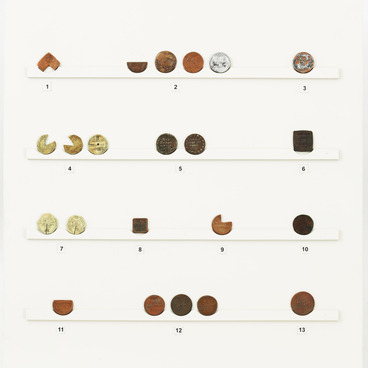A tursouk is a soft leather vessel in which Bashkirs kept koumis. Koumis is a fermented dairy product traditionally made from mare’s milk. It is a traditional drink of the Bashkir peoples. They were nomads, therefore needed vessels and dishes that were convenient for travelling.
#4
Tursouk
#5
#6
Manufacture
#3
This tursouk was made from leather in late19th — early 20th century. Vessels for koumis were sewn from horse, camel or cow skin or from sheep or goat skin. Hair was removed and the skin was treated in a special salt solution. Then it was stitched underside outwards and a bottom was sewn on to make it into a sack. The sack was filled with sand or ashes to keep the shape. Then it was covered with matted sheep wool and hung on poles in a smokery.
#7
A Bashkir smokery of the 19th century looked like a big pit in which pressed animal dung was burnt. In order to improve the taste of koumis and give it a special flavour, birch and spiraea wood was also burned. The tursouk was kept in the smokery for seven-eight days. After smoking, the sack got imbued with the aromas and became hard and leak-proof. Then braided leather handles were attached to the vessel and it was decorated with tendon or horsehair stitches, woolen threads and ropes, narrow strands of colour fabric. The tursouk could be of any shape and size. Normally a sack like that could hold ten-twenty liters of milk. In a yurt, the tursouk always stood on the right side of the entrance.
#8
Using
#9
Mare milk was fermented in vessels on the inner walls and on the bottom of which there had already been fermentation fungi. The milk had good bacteria reproducing in it and turning it sour. So, a little koumis fermented in an old vessel was added to a new tursouk with fresh milk. Mares were milked from two to five times a day. After each milking, women added fresh milk to the tursouk. Then the drink was stirred with special mixers (beshek) to prevent casein (protein) from curdling into big clots. Three-four days later koumis was ready. It was white opaque colour looking practically the same as fresh milk.
#10
Bashkir people were nomadic cattle breeders. Their mares grazed for a long time and gave a lot of milk but it spoilt quickly and had a bad taste if not fermented. So, the nomads invented koumis, a refreshing and tasty drink. They believed that koumis had healing qualities and used it to treat many diseases.
#11
O.E. Kler Sverdlovsk Regional Ethnography Museum
читать дальшескрыть
00:00
00:00
1x
Tursouk
Время создания
Late19th - early 20th century
2
Открыть в приложении
Поделиться

